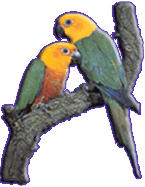|
|
| |
|
|
|
|
EASTERN ROSELLA
Platycercus Eximius |
|
|
| |
|
This parrot species's natural habitat is south-east parts of Australia. Mostly they live in savannas, but it's nothing unussall to see few of the couples living in cultivated areas like big city parks and suberbs. They are nesting in tree trunks and sometimes in tree stumps if the stump is deep enough. |
|
|
| Gender differences are pretty much easy to spot, females have duller coloures. Male has brighter red coloured feathers on the head , female's breasts are yellow-red running from one colour to another, while the male has strictly separated colours one from another. Female's head is a bit smaller than male's, and the position of white feathers in the under wing part is somewhat different. This position of white feathers is very important in defining a sex of an youngster, becouse younsters of this particulare species have mixed feather colourings until the secound molting, which is when they are about eight months old. In the same period they becomes sexually mature.
|
|
|
eastern rosella couple
(on the left-male, on the right-female ) |
|
| Size of eastern rosella is about 30 to 32cm, and she belongs to the class of middle sized parrots. Becouse of its extraordinary coloures: red head, red yellowish green breasts, greenish blue tail, greenish black wings outlined with blue feathers in the summer and yellow, black and green back with fethers that looks like a scales, this bird is also known as small ara. It sings very nice and it's not a noisy bird. It is rather curiouse and temperament when in the move. It walks like duck, staggering around, but it's a great flyer. It's easy to domesticate and train, and it can learn to imitate some number of the words. As it comes from savannas her food consists of savannas plant seeds and local growings. Eastern rosella is very fond of fruit and vegetables, but also like to eat insects from time to time, as to provide proteins. |
|
|
| chickens of eastern rosella
|
|
|
|
| |
|
They mate once or twice a year and sometimes even three times a year, but that is very rare. The female lays 4 to 7 white eggs every secound day, and starts sitting on them after the third. Incubation period lasts for 21 day. After their first flight they stay in the nest for 4 to 5 weeks. In this period they get fully feathered and become mature. After this 5 weeks they leave the nest but still stay close to their parents for another 3 or 4 weeks. When this period pasts they should be separated from their parents, if not there will be fight and offcourse they should start an indipendant life and a new ciclus of mating.
|
| In captivety eastern rosella should be fed with proso, oat, sunflower, bright seed, setaria, sorghum and from time to time with hemp, enriched with vitamins and minerals. For the right seed relation in everyday mix it is the best to ask a breeder.
Eastern rosella is a great pet , undemanding with pleasent voice, very devoted to the owner and has extraordinary feather clority. The life span of this species is 30 years. If you think this is the right parrot for you make sure when buying that you get young and healthy bird. Only breeder can guaratee for this, becouse in most of the pet shops employees don't know enough about this species. Beside seedish food you should feed your bird with some soft food made of grated egg, cookeis and a bit of blue poppy. Bird should get this soft food just for the first moth and no more than one coffee spoon per day. This mix is good for the feather colorit and it's important for the bird's health and good body-built. As for the fresh greens, eastern rosellas should eat leaf of dundelion, carrots, apples, cucamber, spinach and parsley sprig. |
|
|
| As an old and experienced parrot breeder I really think that eastern rosellas are great pets and can give so many. |
m |
|
| |
|
|
| |
|
|
| |
|
|
| |
|
|
|
|
| |
|
|
|
|
|

